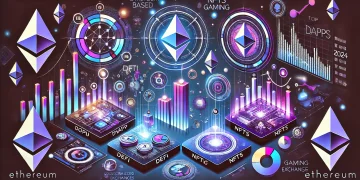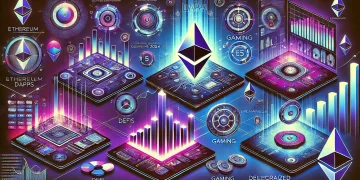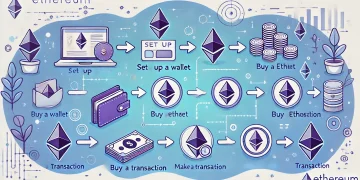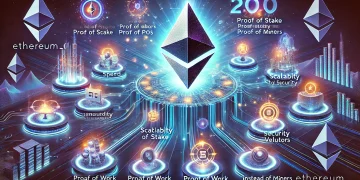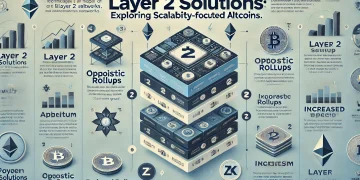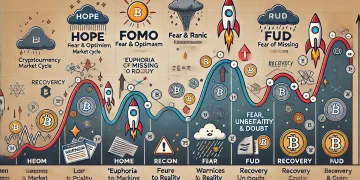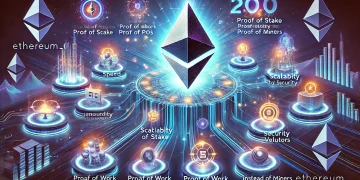Blockchain technology is the cornerstone of the modern cryptocurrency world, providing the framework that supports digital assets like Bitcoin, Ethereum, and countless other cryptocurrencies. But what exactly is blockchain, and how does it work? This article delves into the basics of blockchain technology, its core features, and why it is considered a revolutionary advancement in both financial systems and beyond.
What is Blockchain?
At its simplest, blockchain is a distributed ledger technology (DLT) that records transactions across a network of computers. Unlike traditional centralized systems, where a single entity (like a bank) manages the database, blockchain operates in a decentralized manner. Every participant (referred to as a “node”) has a copy of the ledger, and all updates to this ledger are agreed upon through consensus mechanisms. This ensures transparency, security, and immutability.
The Origin of Blockchain Technology
Blockchain technology was first introduced in 2008 by an individual or group of people using the pseudonym Satoshi Nakamoto. The technology was proposed as the underlying infrastructure for Bitcoin, the first cryptocurrency. Bitcoin was designed as a peer-to-peer payment system that could operate without the need for intermediaries like banks or payment processors.
Nakamoto’s whitepaper, titled “Bitcoin: A Peer-to-Peer Electronic Cash System,” described a method of using blockchain technology to solve the “double-spending” problem that had long plagued digital currencies. The solution was to create a decentralized system where transactions were verified and recorded in a public ledger—this ledger being the blockchain.
How Does Blockchain Work?
Blockchain’s functionality is based on a series of interlocking blocks, each containing a record of multiple transactions. These blocks are linked together in chronological order, forming a “chain” of records. Here’s a basic breakdown of how blockchain works:
1. Transaction Initiation
When a user initiates a transaction (for example, sending Bitcoin to another user), the transaction is broadcast to the blockchain network. The transaction typically includes details like the sender’s and receiver’s public addresses and the amount of cryptocurrency being transferred.
2. Validation
Before a transaction can be added to the blockchain, it needs to be validated. This is where the consensus mechanism comes into play. In most blockchains, validation is performed by “miners” or “validators,” depending on the specific consensus protocol (such as Proof of Work or Proof of Stake).
In Bitcoin, for example, miners solve complex mathematical puzzles to validate transactions. Once the puzzle is solved, the transaction is confirmed and added to a new block. This process is called mining and is central to ensuring the integrity of the network.
3. Block Formation
Once a group of transactions is validated, they are bundled together into a block. This new block is linked to the previous block, creating a chain. Every block contains a unique “hash,” a cryptographic fingerprint that helps ensure the block’s authenticity. If anyone attempts to alter the contents of a block, the hash would change, alerting the network to potential tampering.
4. Block Addition and Distribution
After the new block is created, it is added to the blockchain and distributed across the network. Since every node in the blockchain network has a copy of the ledger, the new block is quickly propagated across the network, ensuring that all participants have the latest version of the ledger.
5. Immutability
One of the most important features of blockchain technology is immutability. Once a block has been added to the blockchain, it is extremely difficult to change or remove. This is because altering any part of the blockchain would require changing every subsequent block, which would require consensus from the majority of the network. This makes blockchain highly secure and resistant to fraud.
Key Features of Blockchain Technology
Blockchain’s structure offers a range of benefits that make it ideal for various applications beyond cryptocurrencies. Here are the key features that define blockchain technology:
1. Decentralization
Blockchain is inherently decentralized, meaning there is no central authority or intermediary controlling the system. Every participant in the network has access to the ledger, and decisions are made through consensus mechanisms rather than a central authority.
2. Transparency
All transactions on a blockchain are publicly recorded and visible to all network participants. This transparency helps build trust, as anyone can verify the authenticity and accuracy of the blockchain’s records.
3. Security
Blockchain’s cryptographic structure provides strong security against tampering and fraud. Each block contains a unique hash that links it to the previous block, making it extremely difficult to alter any part of the blockchain without being detected by the network.
4. Immutability
Once data is added to the blockchain, it becomes nearly impossible to change. This immutability is a key feature that makes blockchain an ideal solution for recording transactions, contracts, and other critical information that must be secure and permanent.
5. Consensus Mechanisms
Blockchain uses various consensus mechanisms to validate and agree upon transactions. Proof of Work (PoW) and Proof of Stake (PoS) are the most common, each with its own advantages and trade-offs in terms of energy consumption, speed, and security.
Blockchain’s Role in Cryptocurrencies
Blockchain technology forms the backbone of cryptocurrencies like Bitcoin, Ethereum, and thousands of others. In this role, blockchain offers several advantages that make cryptocurrencies a viable alternative to traditional money and payment systems.
1. Peer-to-Peer Transactions
Cryptocurrencies allow for direct transactions between individuals without the need for intermediaries such as banks. Blockchain technology makes these transactions possible by providing a secure, decentralized platform where users can transfer value to one another.
2. Digital Scarcity
Blockchain ensures that digital assets like cryptocurrencies are scarce and cannot be replicated or “double-spent.” This is crucial for maintaining the value of digital currencies. For example, Bitcoin’s supply is limited to 21 million coins, and blockchain technology enforces this limit by preventing the creation of more coins beyond this cap.
3. Trustless System
One of blockchain’s most revolutionary aspects is that it allows for trustless transactions. In traditional financial systems, participants must trust intermediaries to process and verify transactions. Blockchain eliminates the need for this trust by using cryptographic algorithms and consensus mechanisms to ensure the integrity of the system.
Applications of Blockchain Beyond Cryptocurrencies
While blockchain is most commonly associated with cryptocurrencies, its potential applications extend far beyond digital money. Here are some industries where blockchain is making a significant impact:
1. Supply Chain Management
Blockchain can be used to improve transparency and traceability in supply chains. By recording every step of the supply chain process on a blockchain, companies can ensure that goods are sourced, manufactured, and delivered ethically and efficiently. For example, blockchain can track the journey of a product from its raw material stage to the final consumer.
2. Healthcare
In the healthcare industry, blockchain is being explored as a solution for secure and interoperable medical records. Patients could have control over their own health data, and authorized healthcare providers could access and update this data securely. This could improve patient outcomes and reduce fraud in medical billing.
3. Voting Systems
Blockchain has the potential to revolutionize voting systems by providing a secure, transparent, and tamper-proof platform for elections. Blockchain-based voting systems could ensure that every vote is counted accurately while preventing fraud and manipulation.
4. Intellectual Property
Blockchain can be used to protect intellectual property by recording the creation, ownership, and transfer of digital assets like art, music, and patents. This could help creators maintain control over their work and ensure they are compensated for its use.
5. Smart Contracts
Smart contracts are self-executing contracts with the terms of the agreement directly written into code. They run on blockchain platforms like Ethereum and can automate transactions, enforce agreements, and reduce the need for intermediaries. Smart contracts are particularly useful in industries like real estate, finance, and insurance.
Challenges and Limitations of Blockchain Technology
While blockchain offers numerous benefits, it is not without its challenges. Some of the key limitations include:
1. Scalability
One of the biggest challenges facing blockchain technology is scalability. As more transactions are added to a blockchain, the size of the ledger grows, making it harder for nodes to process and store the data. Solutions like the Lightning Network and sharding are being developed to address this issue, but scalability remains a concern.
2. Energy Consumption
Blockchain networks that use Proof of Work (PoW) consensus mechanisms, like Bitcoin, are highly energy-intensive. The mining process requires significant computational power, leading to concerns about the environmental impact of blockchain technology.
3. Regulatory Uncertainty
As blockchain and cryptocurrencies continue to grow, governments and regulatory bodies are grappling with how to oversee and regulate these technologies. The lack of clear regulations in many countries creates uncertainty for businesses and individuals using blockchain technology.
4. Privacy
While blockchain provides transparency, it also raises privacy concerns. Public blockchains, in particular, allow anyone to view transaction data, which could lead to potential privacy violations. Solutions like zero-knowledge proofs and private blockchains are being explored to address these concerns.
The Future of Blockchain Technology
Blockchain is still a relatively young technology, but its potential is immense. As developers continue to innovate and address the challenges facing blockchain, we can expect to see even more widespread adoption across a range of industries. From finance to healthcare to supply chains, blockchain technology is poised to transform how we interact with digital assets and information.
Moreover, advancements in blockchain scalability, privacy, and energy efficiency will likely drive the next wave of blockchain innovation. As regulatory frameworks become more defined, businesses and individuals will have greater clarity and confidence in adopting blockchain solutions.
Conclusion
Blockchain technology has revolutionized the way we think about transactions, trust, and decentralization. As the foundation of cryptocurrencies, it has already disrupted traditional financial systems and introduced new ways of transferring and storing value. But its applications extend far beyond digital currencies, with the potential to reshape industries from healthcare to supply chain management.
While challenges remain, the future of blockchain looks bright. As we continue to explore the possibilities of this groundbreaking technology, blockchain will likely play an increasingly important role in shaping the digital economy of tomorrow.

